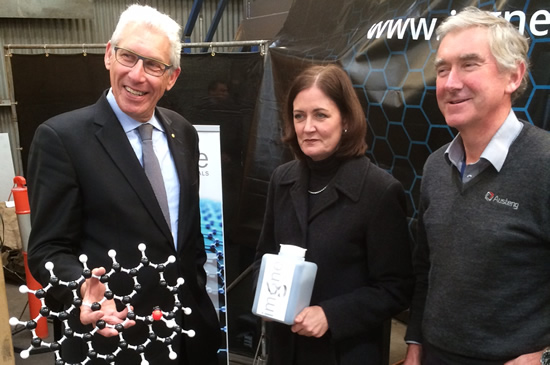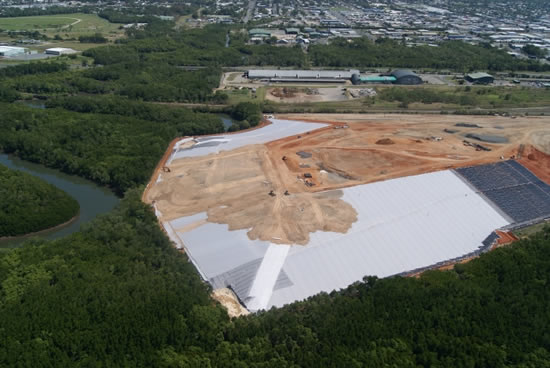The first field trial in Australia for conductive geotextiles enhanced with graphene have been a success, Imagine IM reports. The company, which built Australia’s first commercial scale graphene production plant this year, has worked with Australia’s largest geosynthetics manufacturer (Geofabrics Australasia) to create this new type of geotextile.

The trial was conducted August 18 in Melbourne. The geotextiles, which was coated with imgne® X3 masterbatch, was tested by ExcelPlas, a National Association of Testing Authorities (NATA) accredited facility.
Graphene offers high electrical and thermal conductivity, hydrophobicity, strength, and impermeability to all gases. Layers of graphene could give materials strength exceeding steel, enable self-repairing qualities, and impart an electrical conductivity greater than copper. In geosynthetics, this may create nanocomposite materials with superior anti-clogging properties in geotextiles, heightened leak location ability in lining systems, a wider range of conductive materials, and much more.
The introduction of a conductive geotextile, enhanced by graphene, is significant. This initial product, which is being produced at Geofabrics’ Albury (NSW) facility, might be utilized in a variety of applications. Applications may include heightened leak location and improved construction quality assurance (CQA) for lining systems in landfills, mining, wastewater treatment plants, reservoirs, industrial processing facilities, dams, and other containment projects.
FIELD TRIAL REPORT
Imagine’s field trial report paints a promising future for conductive geotextiles to improve installation quality and performance. The company notes:
The field trials were conducted using standard commercial 2mm thick HDPE geomembrane in a two-layer configuration, ensuring maximum electrical insulation of the tested geomembrane from the earth. This is the most difficult condition for electrical leak detection. Testing was to ASTM standards D6747-04 and D7852-13 using 2m wide, 25m long samples of imgne® X3 conductive geotextile, coated on one side only. Deliberate, controlled holes were drilled in the geomembrane from 5mm diameter down to 1mm diameter.
The field trials confirmed that leaks down to 1 mm hole size—the minimum size tested—were able to be detected in the imgne® X3 coated geotextiles using normal testing methodologies and equipment for trials of this kind.
Uniquely, the trial showed that special geotextile panel joining was not needed. The continuous electrical conductivity between adjacent, treated rolls was achieved through a 100 mm overlap of material. Conductivity was even confirmed down to a 10mm overlap. Also, 15kV test voltages produced constant testing sensitivity at earth-lead distances 1 – 20m, even at points with geomembrane deformations. “Reliable results” were even shown at 5kV test voltages and the trial did not produce any false positives.

“In all tests, standard installation techniques were used,” the company writes, “with no special handling or preparation of the imgne® X3 coated X3 conductive geotextile nor the geomembrane nor the ground itself.”
COMPANY COMMENTS
“We developed imgne® X3 as a graphene-based coating that enables delivery of conductivity in textiles and on other materials without impacting the strength and other characteristics of the materials themselves,” said Phillip Aitchison, COO of Imagine IM. “The development of a conductive geotextile as Imagine IM’s first commercial application of imgne® X3 is a major milestone for us. We have now proven our ability to both manufacture graphene at scale, and also to be able to produce masterbatch solutions that will enable large-scale industrial applications using graphene to make smart materials.”
“These results are extremely gratifying,” Chris Gilbey, CEO of Imagine IM added. “The intent of using imgne® X3 is to provide a methodology for making geotextiles conductive that will lead to substantial economies for end users and to make leak detection more affordable and more accurate.”
A larger field trial with Geofabrics Australasia is being planned. Imagine IM expects to realize its first revenues from sales and licensing of the imgne® X3 masterbatch in Q1 2017.
For more information on Imagine IM, visit www.imgne.com.
For more information on Geofabrics Australasia’s geosynthetics, visit www.geofabrics.co.












The obvious question is “What does it cost?”
interesting source of information on a market with continual product and market innovations